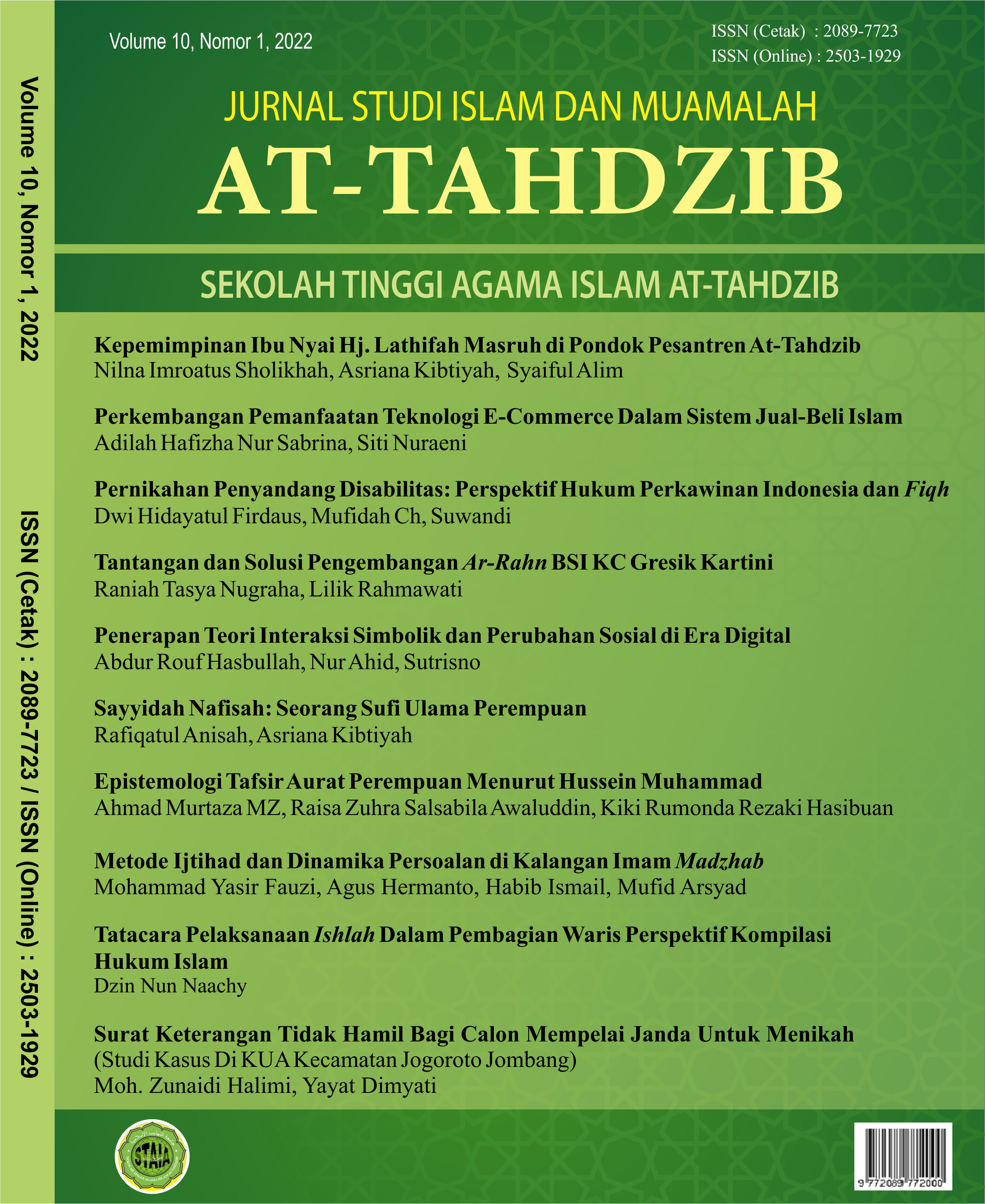Penerapan Teori Interaksi Simbolik dan Perubahan Sosial di Era Digital
Abstract
Background. The digital era is the historical period characterized by the existence of digital technology, including communication and social interaction. The unrealized discoveries in the field of technology will also affect social change greatly, and will also have a very serious impact on education indirectly.
Aim. This paper will elaborate how the theory of symbolic interaction and the theory of social change as a collaborative approach in carrying-out social research and solutions in dealing with the current digital era. the qualitative approach is used in this research with a critical-analytic method to a social case.
Methods. Library research was conducted to analyze the theory of this social change as the data took from many kinds of literature that contained this theory.
Results. Explained in this paper the theory of symbolic interaction initiated by George Herbert Mead and later completed by Herbert Blumer. This symbolic interaction theory has three main key concepts: mind, self, society where the symbols of attitudes, behavior, ways of speaking are seen in the interactions that take place. Meanwhile, the theory of social change initiated by Auguste Comte and Herbert Spencer is a theory about changes in the structure of society that can affect the patterns of social interaction and something that can build human character towards a better process or vice versa.
References
Ardianto, Elvinaro., Komala, Lukiati., & Karlinah, Siti. (2007). Komunikasi massa suatupengantar. Bandung: Simbiosa Rekatama Media.
Ariyani, Nur Indah & Nurcahyono, Okta Hadi. (2014). Digitalisasi Pasar tradisional: perspektif teori perubahan sosial. Jurnal Analisa Sosiologi, 3(1), 1-12.
Aziz, Rizal Fanani & Handoyo, Pambudi. (2017). Interaksi simbolik anggota himpunan mahasiswa pecinta alam Universitas Negeri Surabaya. Jurnal Paradigma, 5, 1, 1-9.
Berger, Artur Asa. (2004). Tanda-tanda dalam kebudayaan kontemporer, Terjemah. M. Dwi Mariyanto & Sunarto. Yogyakarta: Tiara Wacana.
Cahyono, Anang Sugeng. (2016). Pengaruh media sosial terhadap perubahan sosial masyarakat di Indonesia, Jurnal Publiciana, 9, 1, 140-157.
Cohen, Bruce J. (1992). Sosiologi suatu pengantar. Jakarta: Rineka Cipta.
Djazifah, E. R, Nur. (2012). Proses Perubahan Sosial di Masyarakat, Modul Pembelajaran Sosiologi, Universitas Negeri Yogyakarta.
Haryanto, Sindung. (2012). Spektrum teori sosial dari klasik hingga postmodern. Yogyakarta: Ar-Ruzz Media.
https://www.kominfo.go.id/content/detail/8791/turnbackhoax-komunitas-online-anti-hoax-di-indonesia/0/sorotan_media. Diakses pada tanggal 11 Januari 2022
Ihsanudin. (2019). Polemik “Tulisan Arab†pada busana Agnes Monica (Analisis teori interaksionisme simbolik). Palita: Journal of Social-Religion Research, 4,1, 47-60. DOI: 10.24256/pal.v4i1.526
Juditha, Christiany. (2018). Interaksi simbolik dalam komunitas virtual anti hoaks untuk mengurangi penyebaran hoaks. Jurnal Pikom: Penelitian Komunikasi dan Pembangunan, 19, 1, 17-72.
Lubis, M. Syukri Azwar. (2018). Dampak perubahan sosial terhadap pendidikan. Jurnal Al-Ikhtibar, 5, 2, 633-634.
Mulyana, Dedi. (2002) Metodologi penelitian kualitatif. Bandung: Pemuda Rosdakarya.
Paul B. Horton & Chester L. Hunt. (1989). Sosiologi, Jilid 1 dan 2. Jakarta: Erlangga.
Prasetya, Andina., Nurdin, Muhammad Fadhil., & Gunawan, Wahju. (2021). Perubahan sosial masyarakat dalam perspektif sosiologitalcott parsons di era new normal. Sosietas Jurnal Pendidikan Sosioogi, 1, 1, 929-939.
Rahardjo. (1999). Pengantar sosiologi pedesaan dan pertanian, Yogyakarta: Gadjah Mada University Press.
Ram, Aminudin. (1992). Sosiologi. Jakarta: Erlangga.
Ranjabar, Jacobus. (2015). Perubahan sosial teori-teori dan proses perubahan sosial serta teori pembangunan. Bandung: Alfabeta.
Ritzer, George & Goodman, Douglas J. (2007). Teori sosiologi modern. Jakarta: Kencana.
Salim, Agus. (2002). Perubahan sosial sketsa teori dan refleksi metodologi kasus Indonesia. Yogyakarta: Tiara Wacana.
Sobur, Alex. (2004). Semiotika komunikasi. Bandung: Pemuda Rosda Karya.
Soekanto, Soerjono . (1990). Sosiologi suatu pengantar. Jakarta: Raja Grafindo Persada.
Soeroso, Andreas. (2008). Sosiologi 1. Jakarta: Yudhistira.
Sunarto, Kamanto & Scott, John. (2016). Sosiologi perubahan sosial perspektif klasik, modern, posmodern dan poskolonial. Jakarta: Raja Grafindo Persada.
Umiarso & Elbandiansyah/ (2014). Interaksionisme simbolik dari era klasik hingga modern. Jakarta: Raja Grafindo Persada.
Wibowo, Arif. (2018). Analisis interaksionisme simbolik masyarakat maya terhadap wacana agama di media sosial facebook,. Fikrah: Jurnal Ilmu Aqidah dan Studi Keagamaan, 6, 1, 163-186. DOI: 10.21043/fikrah.v6iI.2875
Wirawan, Ida Bagus. (2014). Teori-teori sosial dalam tiga paradigma (Fakta sosial, definisi sosial, & perilaku sosial). Jakarta: Kencana.
Yohana, Angel & Saifulloh, M. (2019). Interaksi simbolik dalam membangun komunikasi antara atasan dan bawahan di perusahaan. Jurnal Wacana, 18, 1, 128.
Copyright (c) 2022 At-Tahdzib: Jurnal Studi Islam dan Muamalah

This work is licensed under a Creative Commons Attribution 4.0 International License.

Jurnal Studi Islam by At-Tahdzib is licensed under a Creative Commons Attribution 4.0 International License.
Based on a work at http://ejournal.kopertais4.or.id/mataraman/index.php/tahdzib





